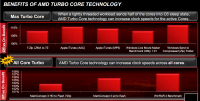 Xtremehardware
La nuova risorsa italiana di hardware e overclock
Xtremehardware
La nuova risorsa italiana di hardware e overclock
Conclusions and considerations
AMD is back with a new architecture optimized for better performance, area and consumption ratio, hence the cost of production. Every single item was chosen to be the best compromise. Reducing consumption can rise clock frequencies and allows for higher turbo.
AMD's approach used to resource sharing is called Clustered Multi Thread (CMT). Unlike Intel's SMT, this approach does not sacrifice too much performance in multi-threaded, when two threads are competing for resources in the module, since only the underutilized units were actually shared and additionally enhanced, because they took the place of two units.
AMD is finally up with the Intel instruction set and actually implements its own set of instructions, the XOP and FMA4, which implement the 4-way FMA (4-way Fused Multiply Accumulate, i.e. the calculation of the formula d = a + b * c, contrary to the FMA 3, which calculates the formula a = a + b * c, destroying a register and requiring a rescue, should serve its content), which delivers great advantages in optimized code:
Finally, the turbo core gives tangible benefits on the performance, trying to exploit the untapped potential of TDP by the various software:
The Bulldozer die in 315 square mm includes 8 cores for a total of 2 billion transistors, can operate at a frequency of over 4 GHz staying in a TDP of 125W. This is certainly an excellent result if we consider the past architectures of both Intel and AMD.
AMD has produced the first 8-core x86 CPUs as it defines it, though that does not have the performance you expect from a real eight-core as the sharing of parts of cores, however, has its disadvantages. From the standpoint of performance, they are approximately aligned with those of an Intel CPU with 4 cores and capable of handling 8 threads. We would like to say this especially for inexperienced users who may mistakenly take the trivial association "CPU with more cores = more powerful CPU."
With this CPU, AMD also has a new record of extreme overclocking frequency, equal to 8429MHz in liquid helium. These two records are a good omen for the success of the CPU, confirmed by preliminary tests carried out by AMD. This certainly is not enough to define the FX-8150 the fastest CPU on the market, at least not in absolute terms.
In the coming days we will publish a detailed performance analysis of this new architecture from AMD, with extensive tests carried out by our staff, as well as a deeper analysis of the architecture. Stay tuned!
Marco Comerci
- << Indietro
- Avanti


